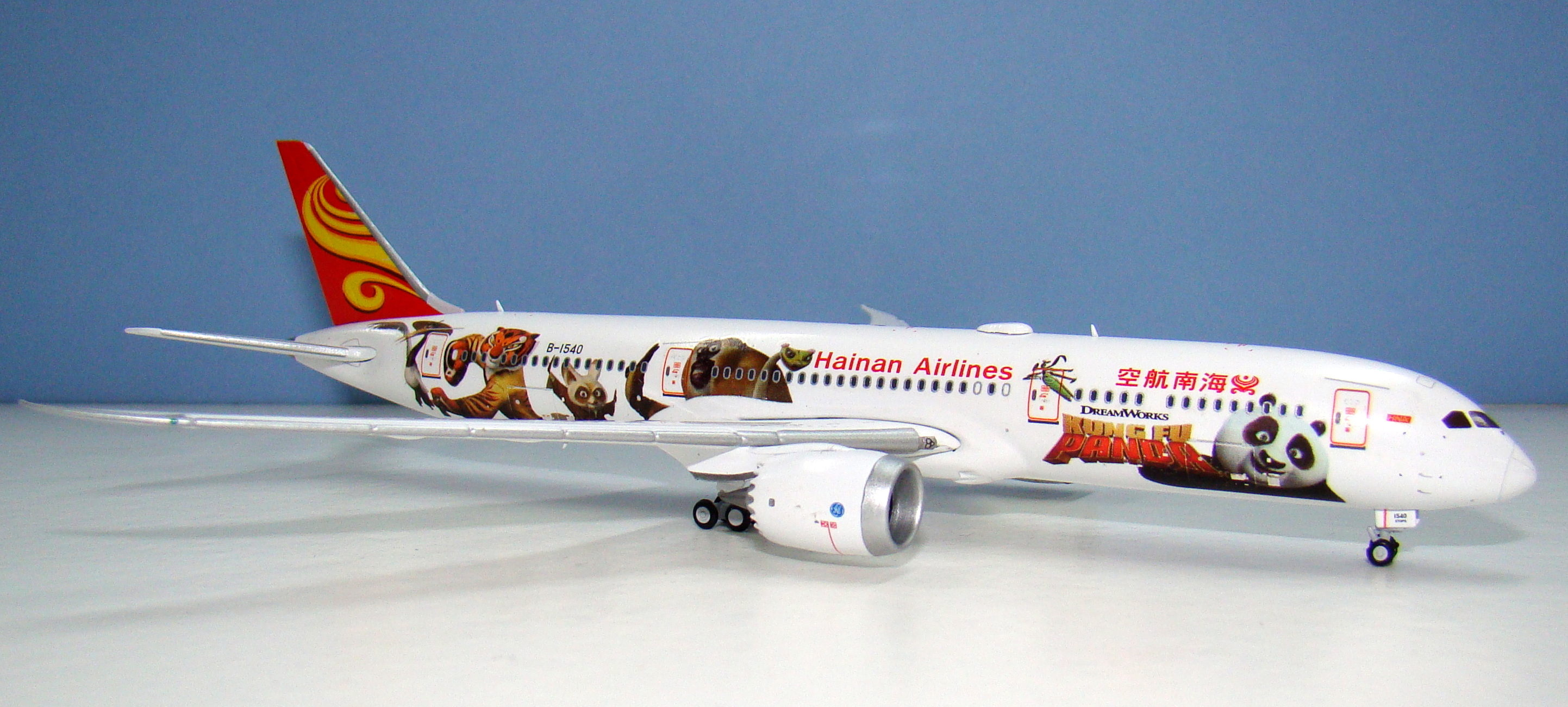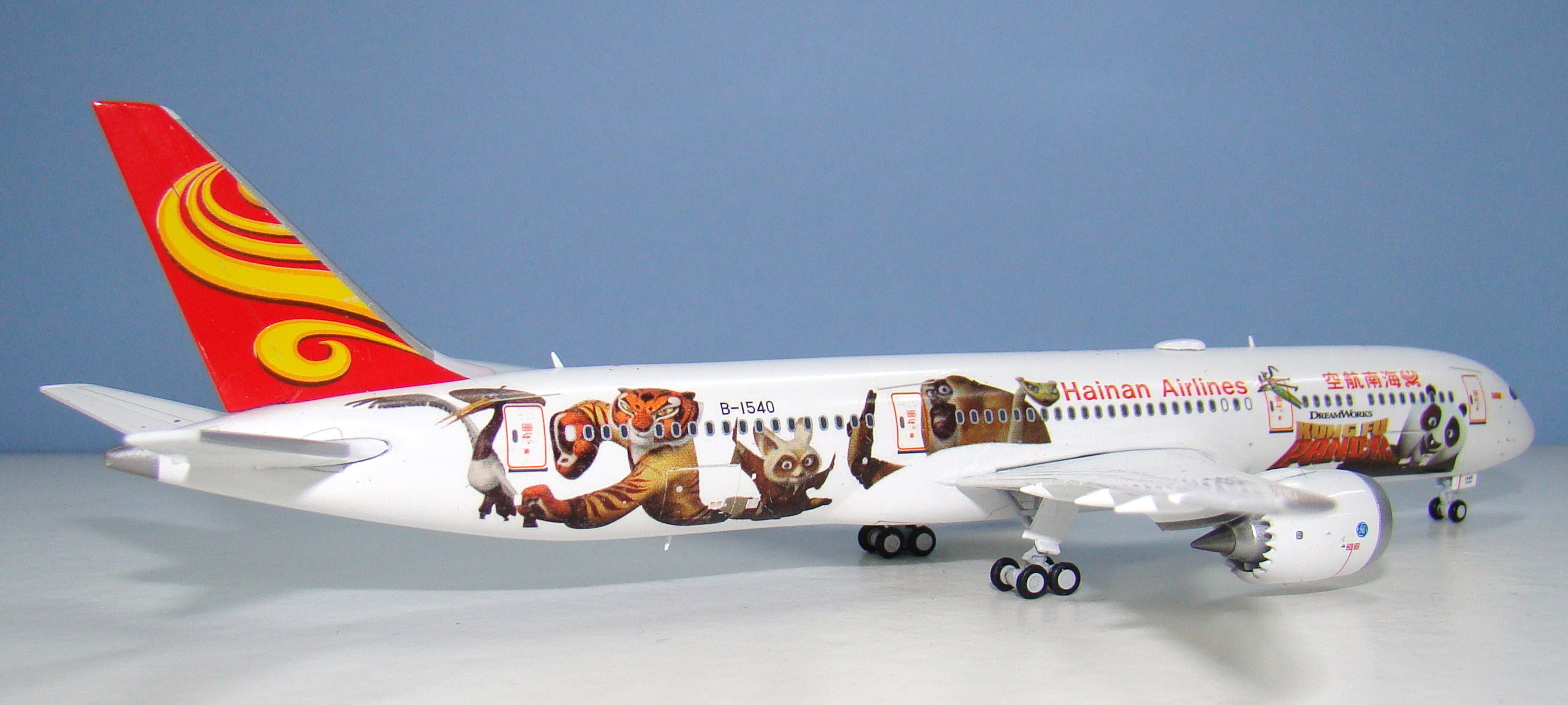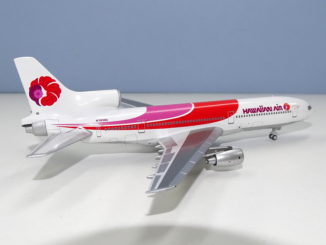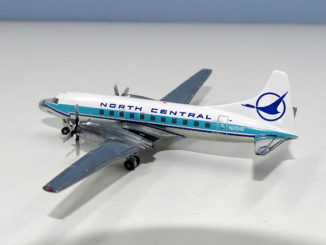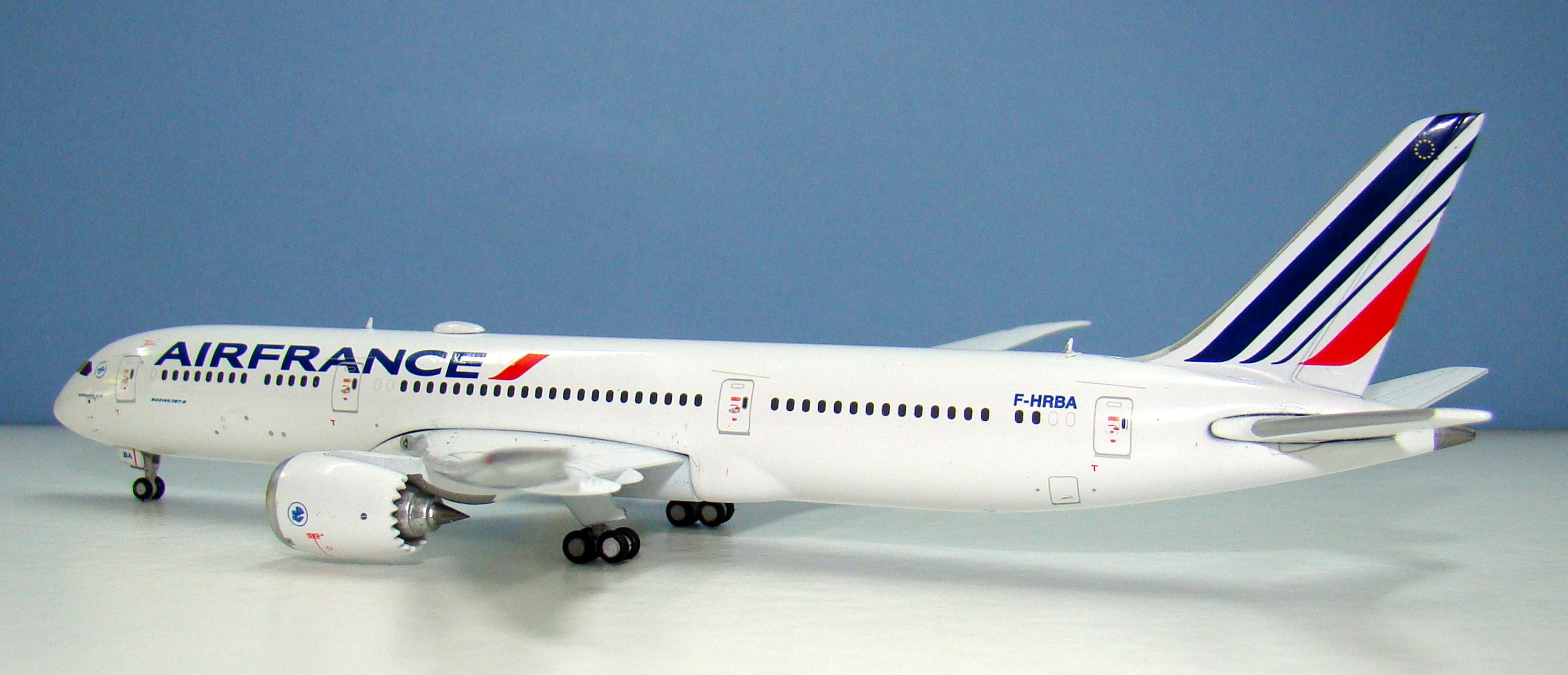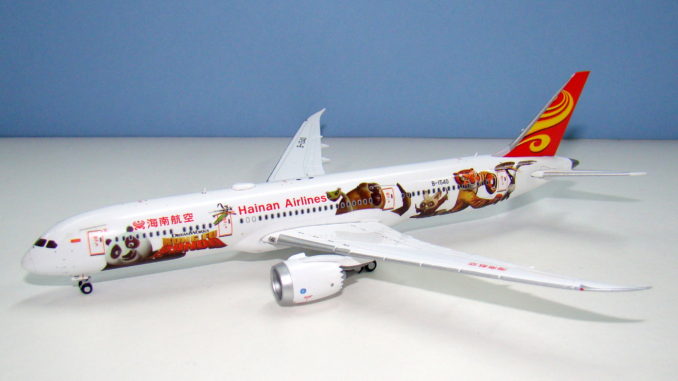
JC Wings have a new mould for their 787-9! Not long ago I reviewed an Air France Gemini Jets 787-9 and, as we know, their models are made by and use JC Wings moulds; That 787 had a cradle mount mould with a large wing seam, which compared unfavourably to the offering of their rival Phoenix. What I didn’t appreciate then was JC Wings have updated the mould and with this entertaining release let us take a close look at the new mould and see if it is master of the 787s.
THE REAL THING
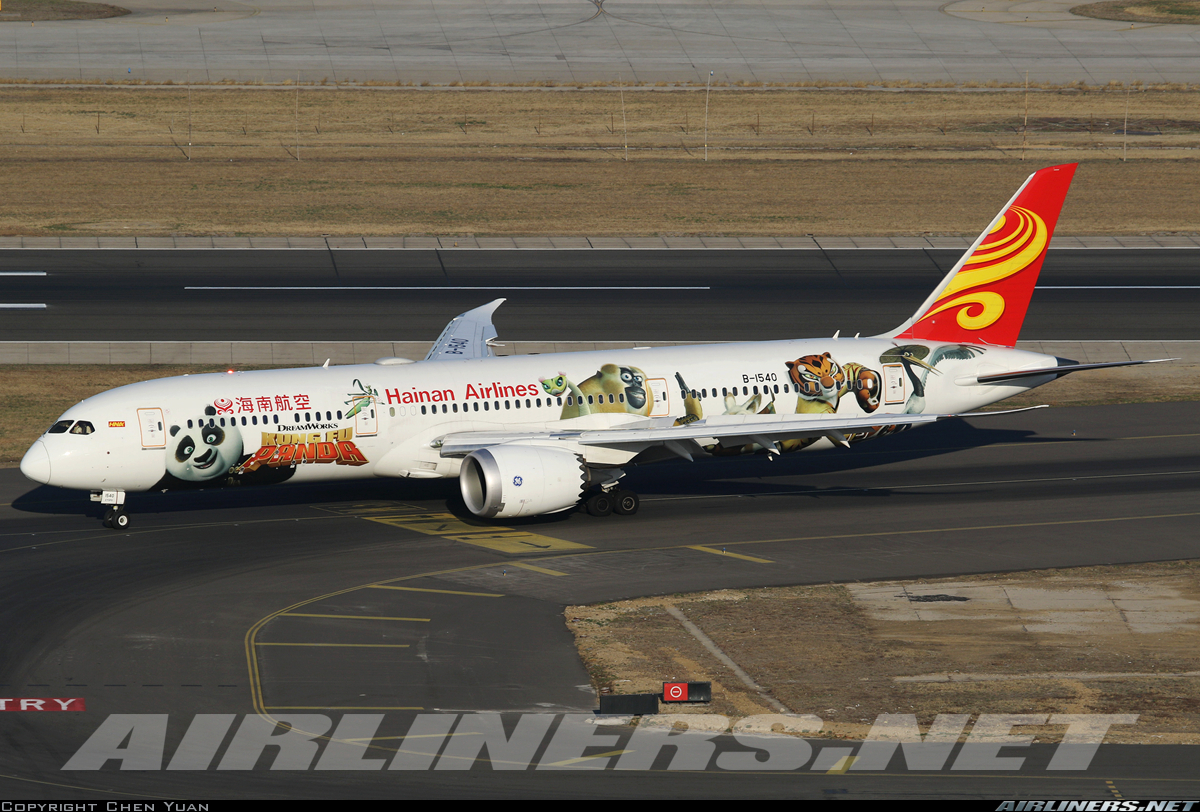
Hainan Airlines and its parent company the HNA Group have grown massively since the early 2000s when Hainan was still a small regional airline operating a handful of 737s. The HNA Group has plans to become one of the world’s top 50 companies by 2030 and has spent more than $3 billion on foreign acquisitions. Hainan Airlines has grown into the fourth big airline in China and in recent years has pushed for a major expansion of its international network, especially focused on trans-pacific routes to the USA and Canada.
In March 2015 the HNA Group placed a huge order for 30 787-9s, in addition to the 10 787-8s already in service, with which to serve this new network. The first, B-7880, was received in June 2016 and was followed by several others before international operations began in September connecting Beijing with Las Vegas. The aircraft are equipped with a 289 seat two class configuration. By the end of January 2017 nine 787-9s were in service and are used on flagship routes across the Pacific like Los Angeles, Boston, San Jose and Toronto. Additionally the aircraft are also still used on domestic services between Beijing and Guangzhou.
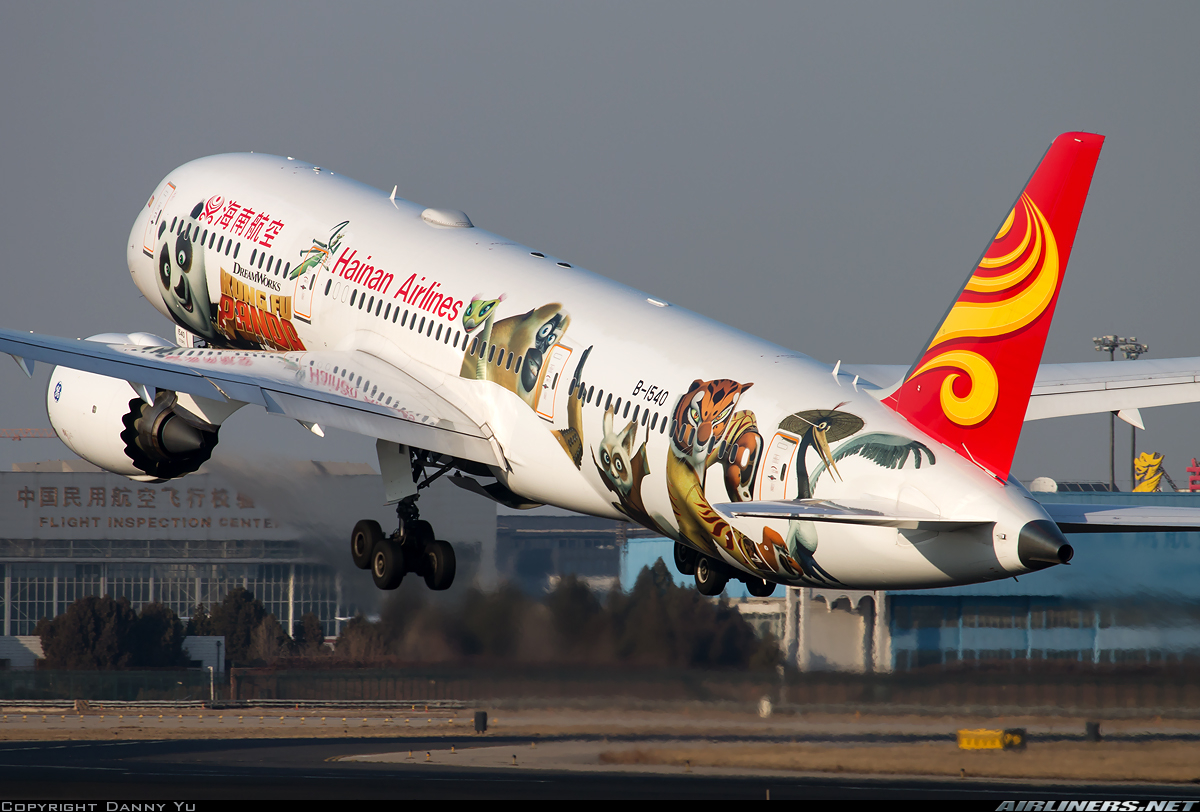
In June 2016 Hainan reached agreement with DreamWorks Animation to create a series of 6 Kung Fu Panda liveries to be displayed on 787-9s. The liveries will be worn for 3 years and the first was rolled out on the almost new B-1540 on October 1. The aircraft has since been joined by an even more colourful red bodied sister and Po and friends will be a feature of Hainan’s ever increasing long haul network for years to come.
THE MODEL
The format for my reviews is to split them into three key areas:
- The mould of the aircraft
- The paint and livery
- Printing and quality control
Each can get a maximum score of 10 for a section giving a maximum combined total score of 30.
THE MOULD
In my review of the earlier JC Wings mould I said I didn’t have any issues with the shape but where the mould fell down in comparison to the Phoenix mould was in two areas – seams and antennae. The new mould certainly is an excellent representation of a Boeing 787. In fact looking at the fuselage and wings it is actually very difficult to tell the difference between the Phoenix mould and the new JC Wings mould. That is a hallmark of the excellence of both moulds. In detail however there are differences to be found.
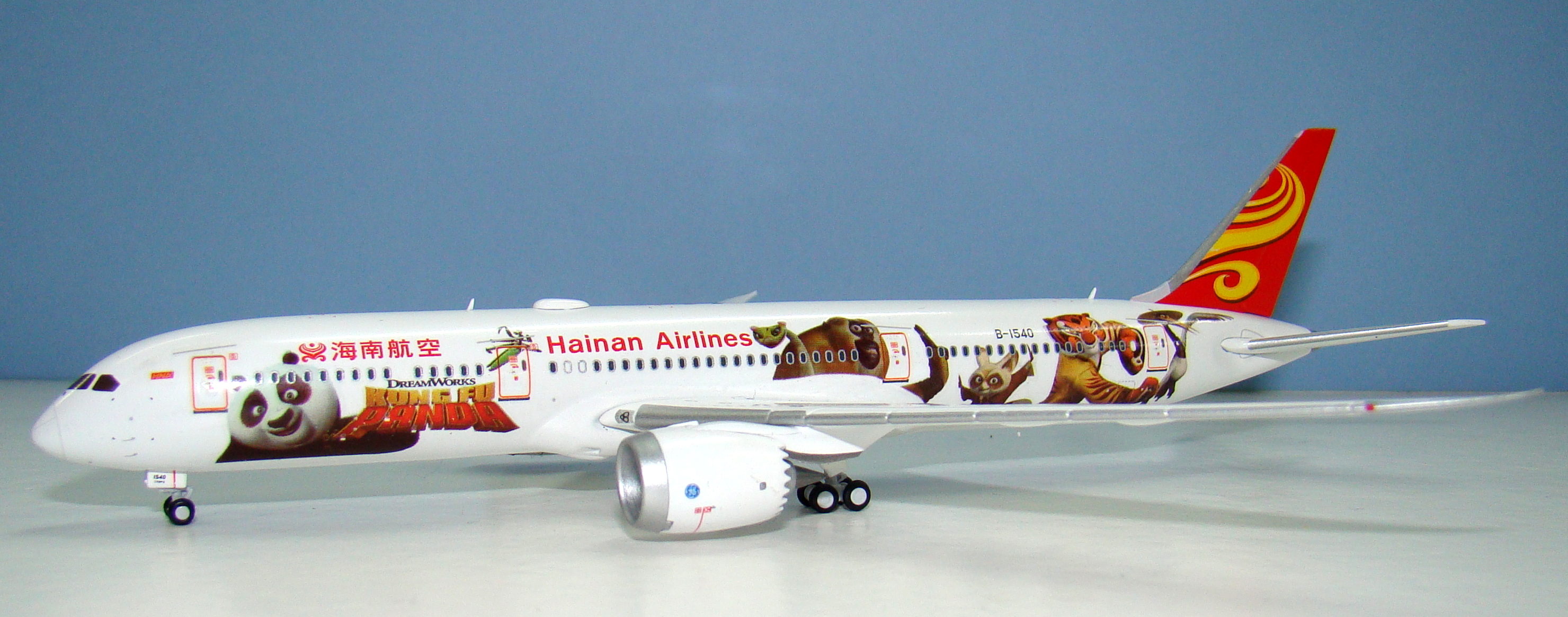
The nosegear leg of the JC Wings model is better shaped with the rear process smaller and lower, however the tyre hubs continue to be a weakness of JC Wings models in general. Another difference is the rear wing join. JC Wings have two versions of this mould – flaps up and flaps down. This has meant they have had to work on getting the rear of the wing join correct in detail and they have. On the Phoenix it is a straight join and lacks the fuselage strake present in the real thing. The JC Wings mould has it properly detailed.
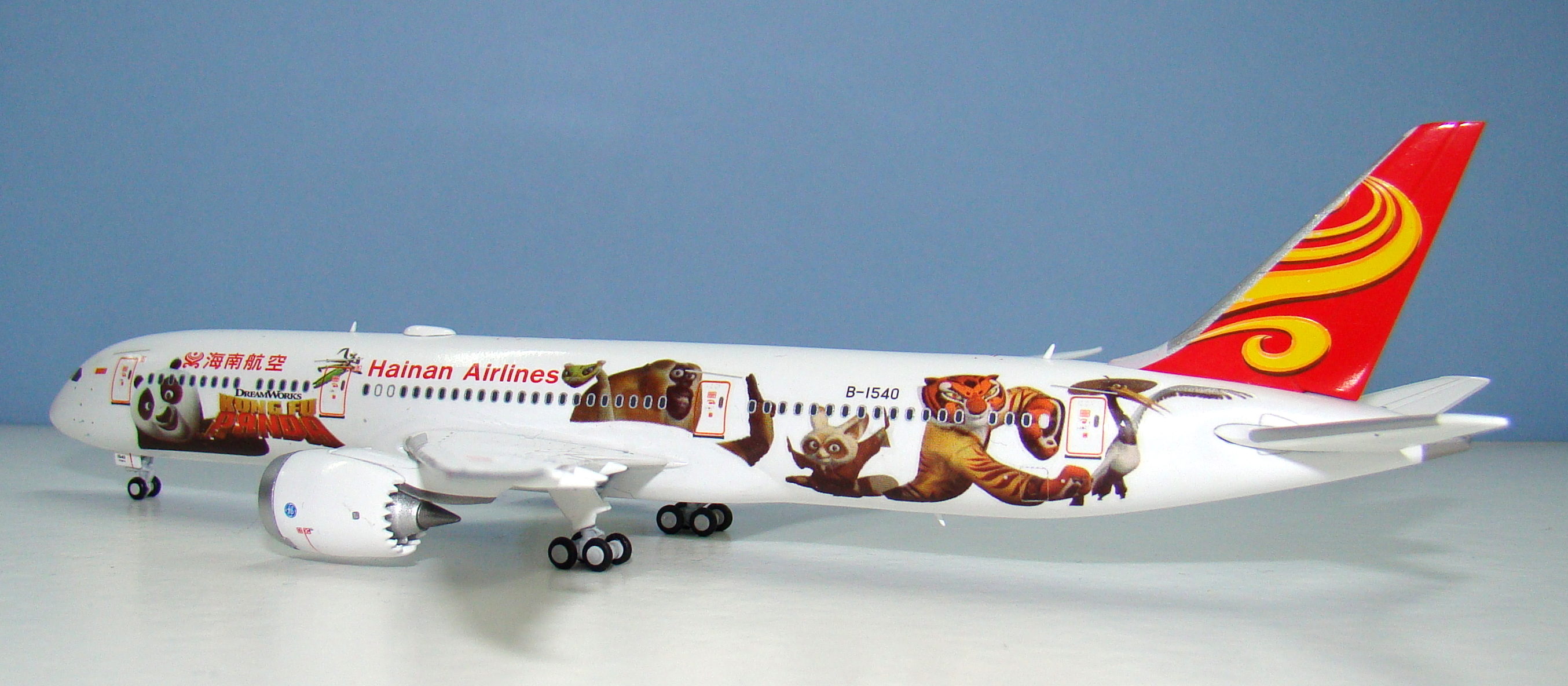
The fuselage detailing on the underside of the JC Wings 787 is also excellent, whereas on the Phoenix there is no detailing to show inlets or bumps. Lastly the JC Wings mould has a more correct flat ended tailcone, whilst the Phoenix tailcone is too pointed.
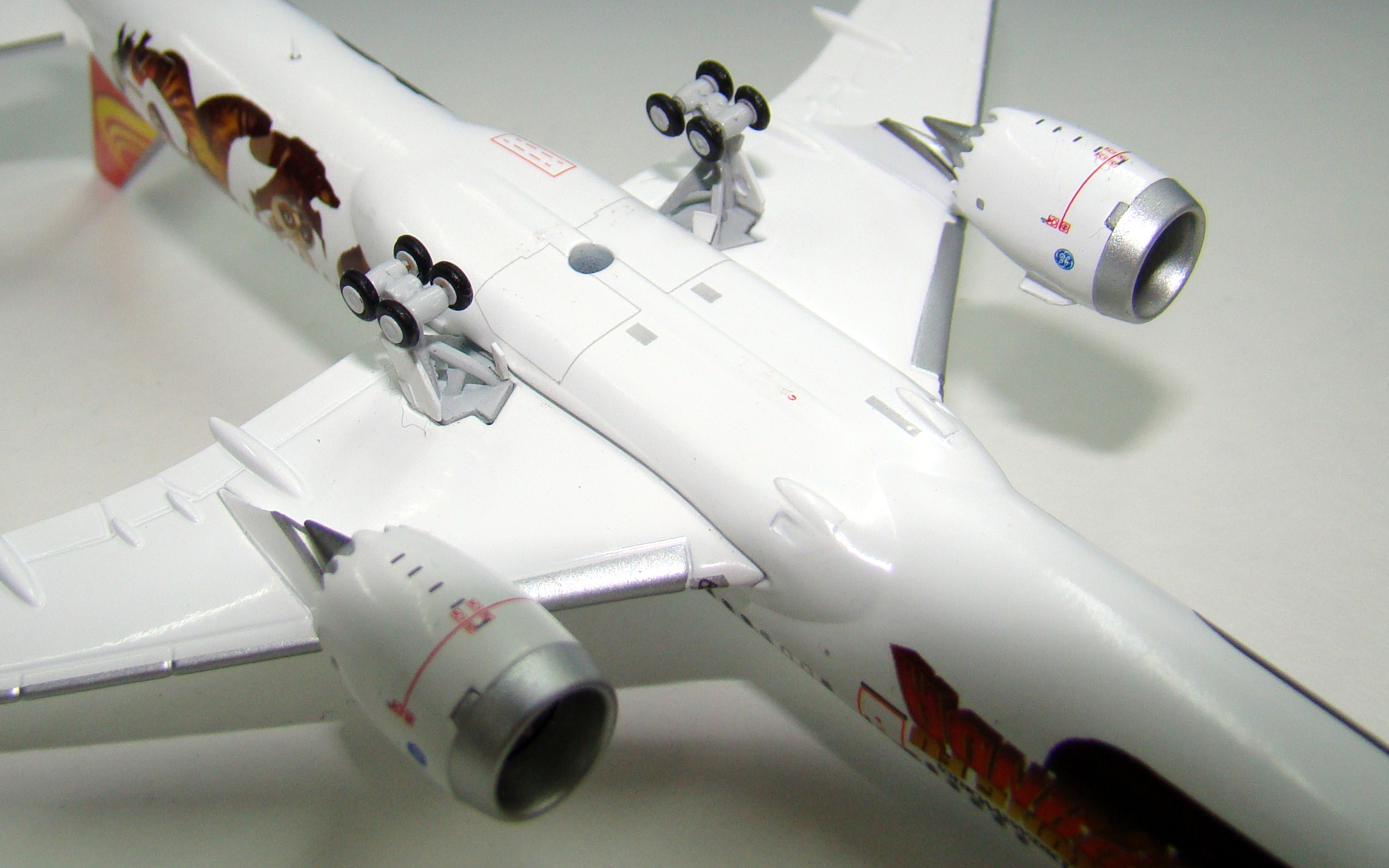
The new wing fuselage join, with slot in wings, is a triumph and beautifully takes into account the curving bulge where the two meet. It looks better than the Phoenix and miles ahead of the clumsy cradle mould seam on the first mould JC Wings had. Interestingly Gemini Jets are still at this point in time using the old mould (see the recent Qantas release) but it is surely only a matter of time until they too adopt this new mould. I should also mention that this 787 has the lovely see through engines.
JC Wings have also modified the antennae the mould has and added in the rear fuselage underbody antenna. They do however still lack the third, smallest and most rearward, antenna on the fuselage roof just ahead of the tail. Additionally they continue to only outline rather than show in relief the small bump just aft of the wing on the fuselage top. This is now the only area where the mould is inferior to the Phoenix version.
So JC Wings have really pulled a great mould out of the bag with this update. The new 787-9 is now markedly superior to the Phoenix mould, except for the missing antennae and small bump on the fuselage roof. In detail almost everywhere else (except wheelhubs) the mould is spot on. It’s a great effort.
SCORE – 9
PAINT & LIVERY
Airline liveries continue to get more complicated as printing and decal technology is refined. This can be problematic for the model manufacturers who now need to show a very high level of detail on markedly smaller versions than the real thing. JC Wings has come in for some criticism in the past (check out the Cargolux cutaway livery model) around these kind of detailed livery decals being printed and how they have done will make or break this model’s reputation.
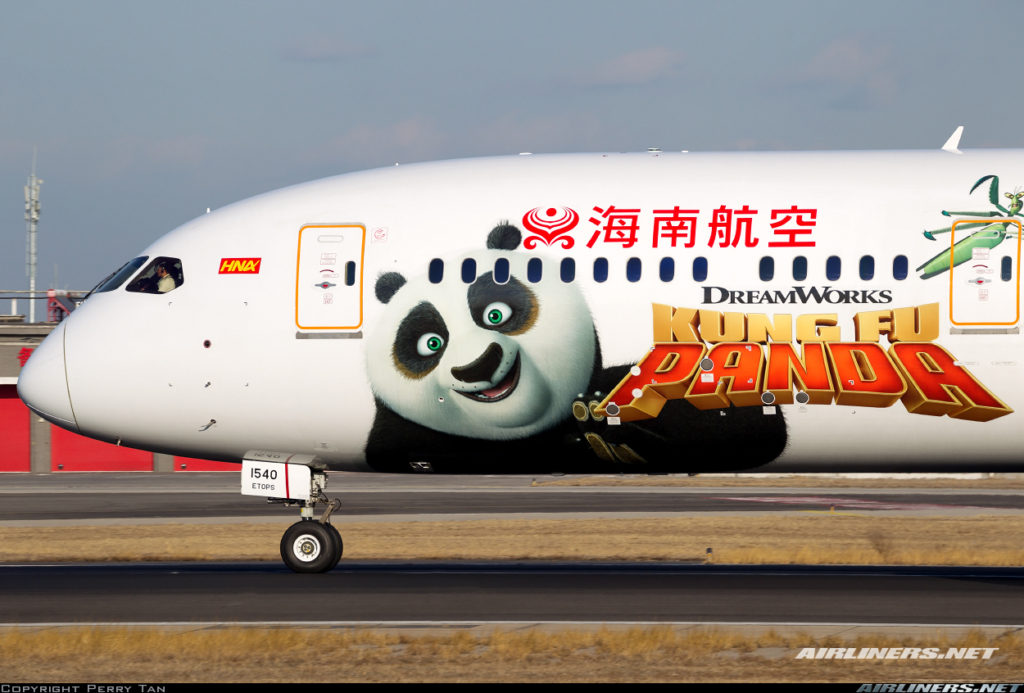
This special scheme takes over the entire fuselage of the 787 and replaces the whole original Hainan livery excepting the tail. Having a young son myself I am all too familiar with the story of Po the Panda, who becomes the Dragon Warrior almost by accident. Po features on the livery along with his friends in the Furious Five and the Dustin Hoffman voiced Master Shifu.
On the port side the order of characters is Po and Mantis before the wing, Viper and Monkey over the rear of the wing and Shifu, Tigress and Crane on the rear fuselage. Although the film series has 3 entries and a cartoon series nowadays, the titles merely indicate the generic Kung Fu Panda brand rather than any of the sequel movies.
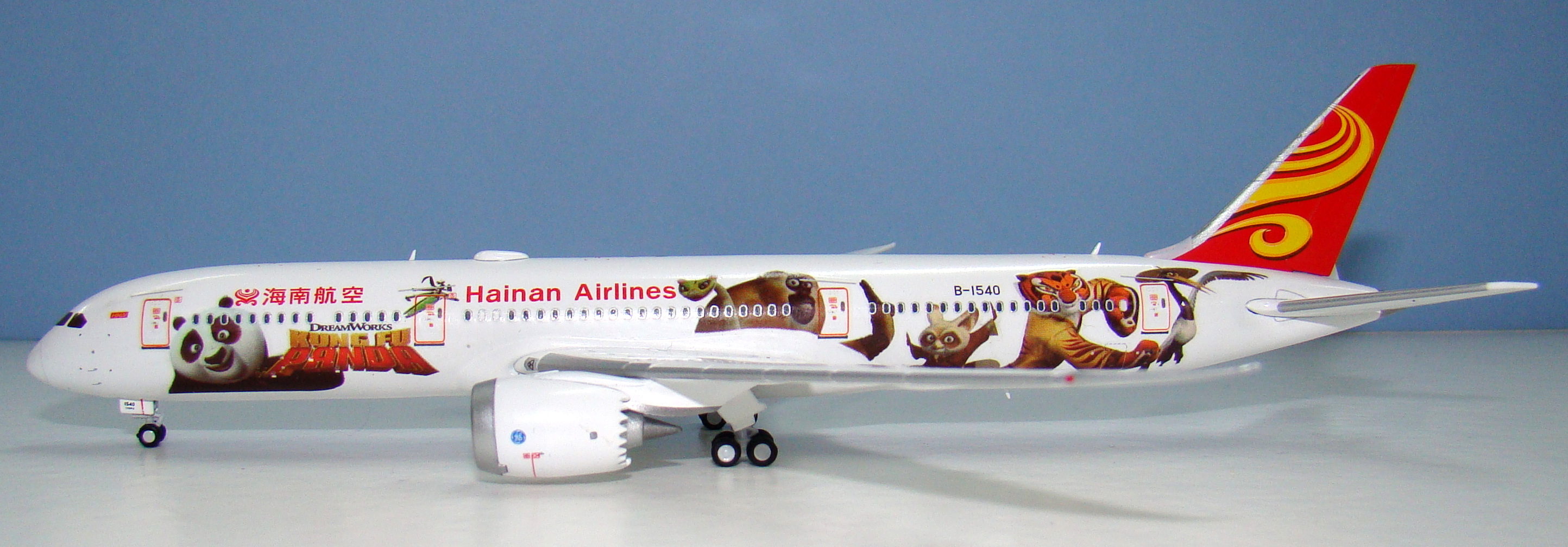
Having a significantly sized Hainan Airlines fleet in my collection I have noticed that Phoenix use a completely different colour for their Hainan Airlines releases to JC Wings and Aeroclassics. Phoenix use an orange colour whereas the other two use a red. I have spent some time trying to work out which is correct. In promotional material and in bright sunlight the darker colour looks correct, but in hazier conditions the tail looks orange. I can’t decide. It isn’t noticeable until you have a mixed fleet like I have when it becomes rather obvious. On this model only the tail is impacted anyway. One thing I can say is JC Wings have rather overdone it with the shadowing around the underside of the curves on the tail logo. It’s not a big issue.
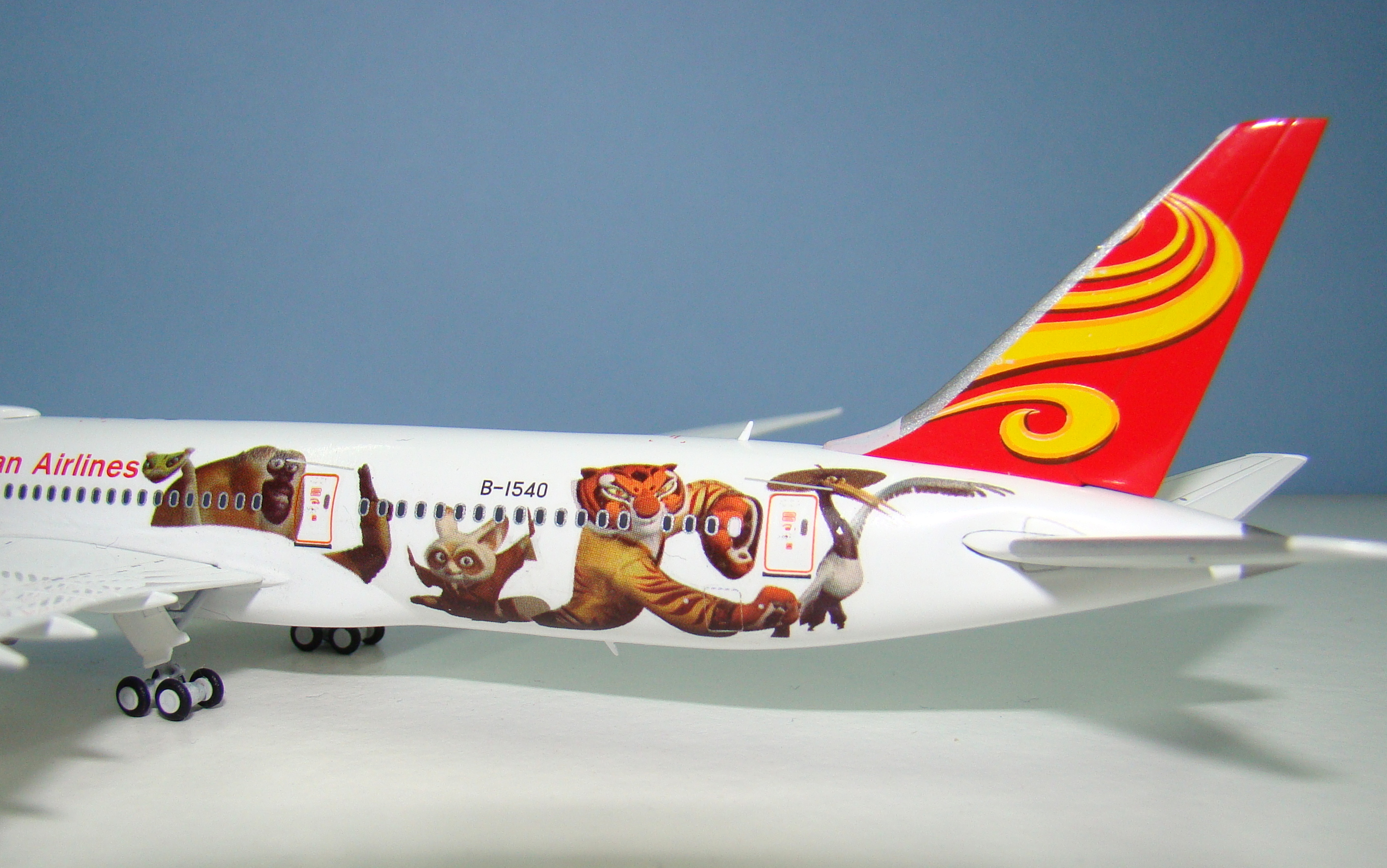
The rest of the livery is the Panda decals. Position wise they are almost perfect. My only criticisms on placement are that Crane’s wing is too thin and the lower border of the designs does not curve far enough under the fuselage. From the side for example you should not be able to see the bottom of the Po decal at all. The designs themselves are excellently printed. Even under a magnifying glass the detail holds up and there is none of the poor definition seen in the likes of the Cargolux release. Colour is however more of an issue as the designs themselves are sometimes clearly too dark. This is most obviously clear on Monkey, Master Shifu and the bottom of Po. In fact the Po element is so dark that it is hard to see his hand under the letter P of Panda.
Nonetheless despite some minor issues I applaud the application of this very difficult livery. The colours are a little dark across the board and the lower margins of the characters not low enough, but the detail is otherwise excellent.
SCORE – 8
PRINTING & QUALITY CONTROL
JC Wings have been spending lots of money on improved moulds but it is little good if they can’t put the models together or print them properly. I am glad to say that the printing on this model is excellent. Small markings like the ‘1540 ETOPS’ text on the nosegear doors, engine logos and cut here panels are all present. The printing of the HNA group titles ahead of the main entry door is however a little indistinct. The printing and detail on the underside of the fuselage is a vast improvement over the Air France 787 using the old mould.
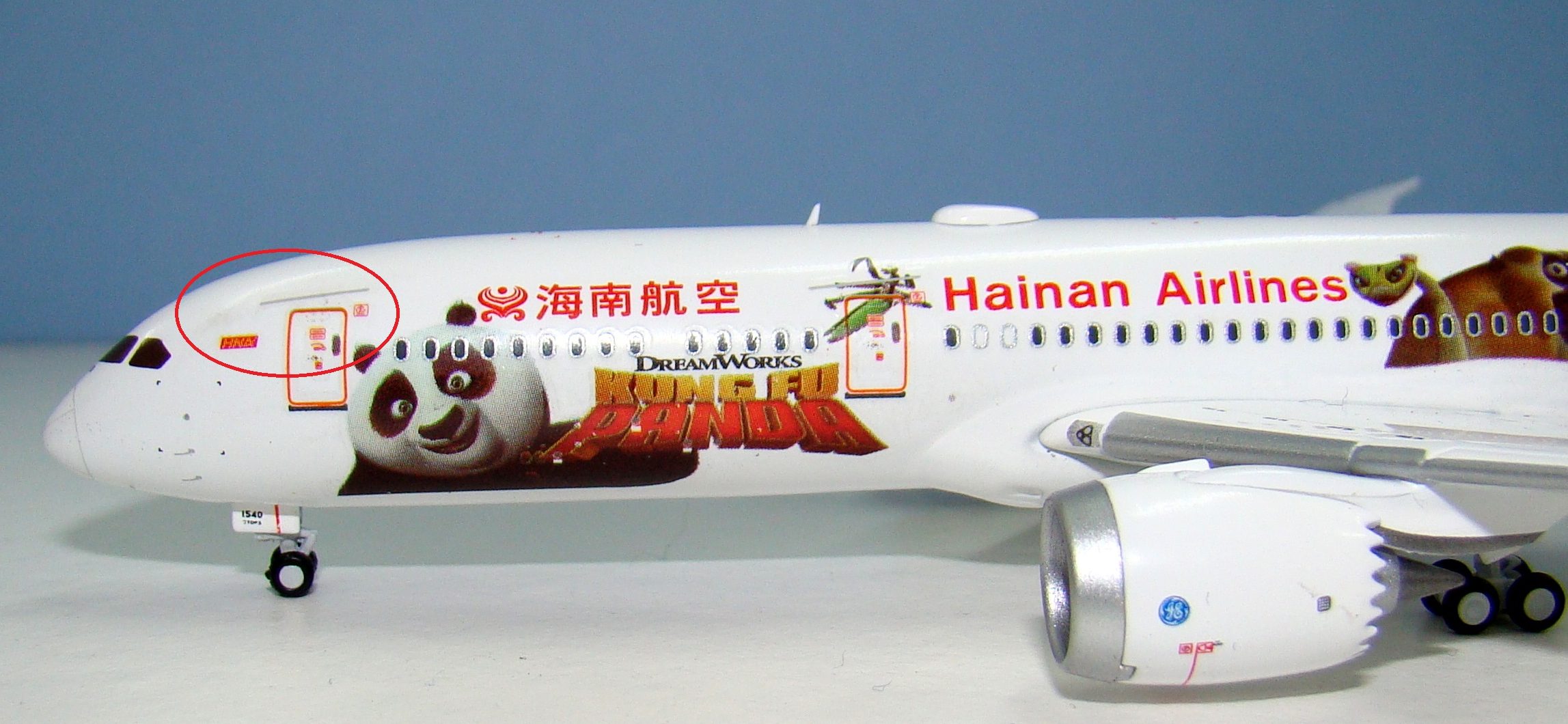
Putting the model together is easily the weakest part of the entire thing. Fortunately all the main elements are attached correctly but there are a selection of small issues, which whilst not massively harming the model do lose it points. The worst offenders are some slight, but noticeable, fingerprint scuff marks just by the HNA logo forward. Clearly the model has been held here by someone with dirty hands or gloves. It’s worse on the port side but is evident on the starboard too. If it were much heavier it would ruin the model and the manufacturers simply must do better in this area.
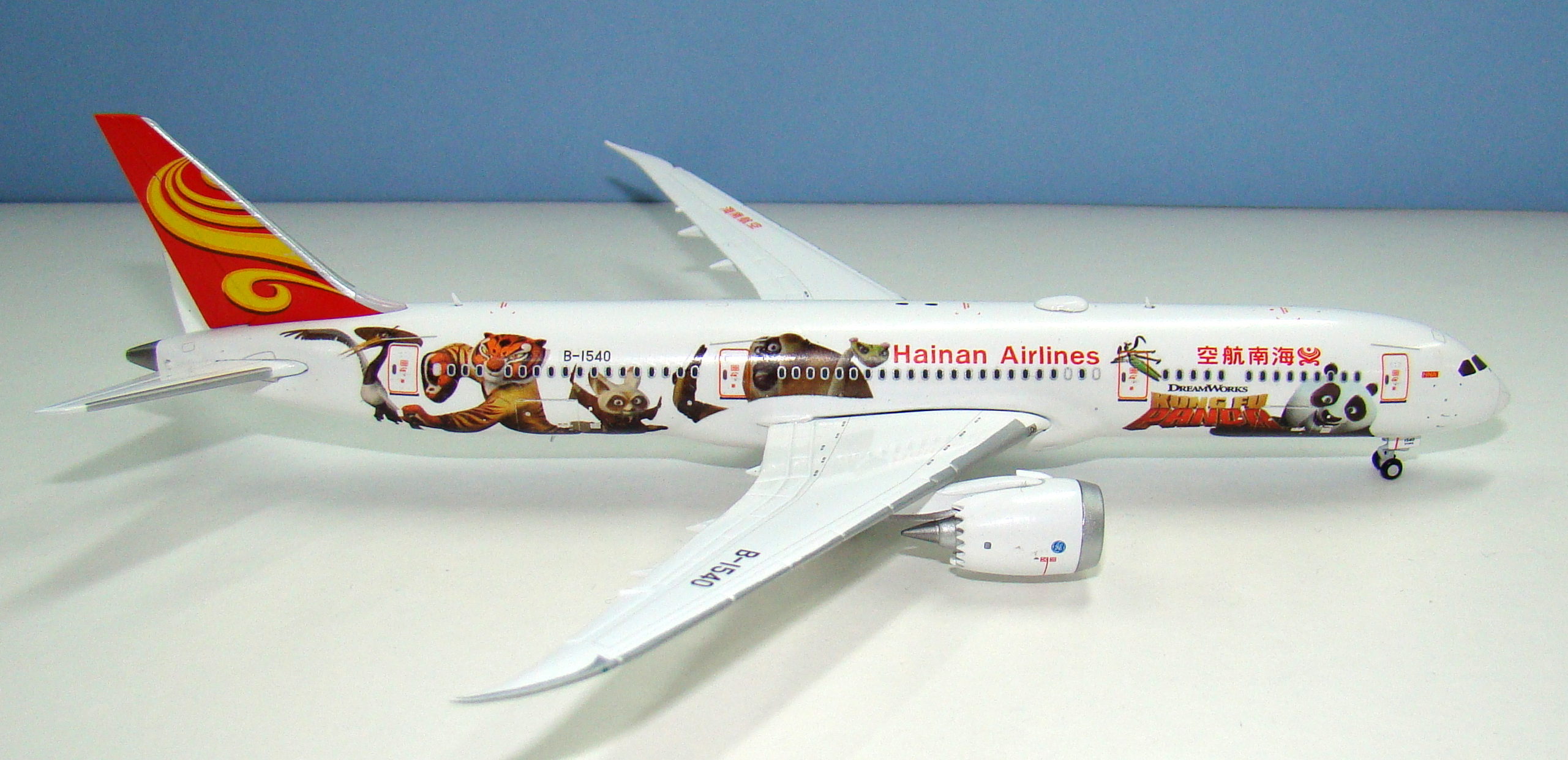
The other three issues are minor and common. The large satnav dome is actually quite well fitted, certainly vastly better than on the Air France 787 I reviewed, however on the starboard side the lower edge is slightly nicked and uneven. Secondly the starboard wing isn’t fitted as well as the port with a more noticeable gap. Lastly the underside antenna is loose and prone to moving. Hopefully it’ll stay attached as the model will be behind glass on display. On the plus side the tyres do not have tabs and all roll well enough.
There was a time when I was scared to even order JC Wings models due to quality issues so in relation to that this model is more than fine. However the finger marks are an issue that is costing this model a few marks.
SCORE – 7
CONCLUSION
The result of JC Wings updated mould is that they now have the best 787-9 on the market. I will be pushing my own 787 purchasing their way from now on, especially as they also have the flaps down version of the mould. With this model in particular they have also shown that they can present a complicated livery with good detail, even if the colours are a little off. The only place for me that the model falls down is the familiar quality issues. Fingerprint scuffing seems common with their (and Gemini’s) larger models and is quite offputting. Nonetheless this model is a beauty and one that also delighted my, usually aviation shunning, 6 year old when he saw it too.
FINAL SCORE – 24/30


